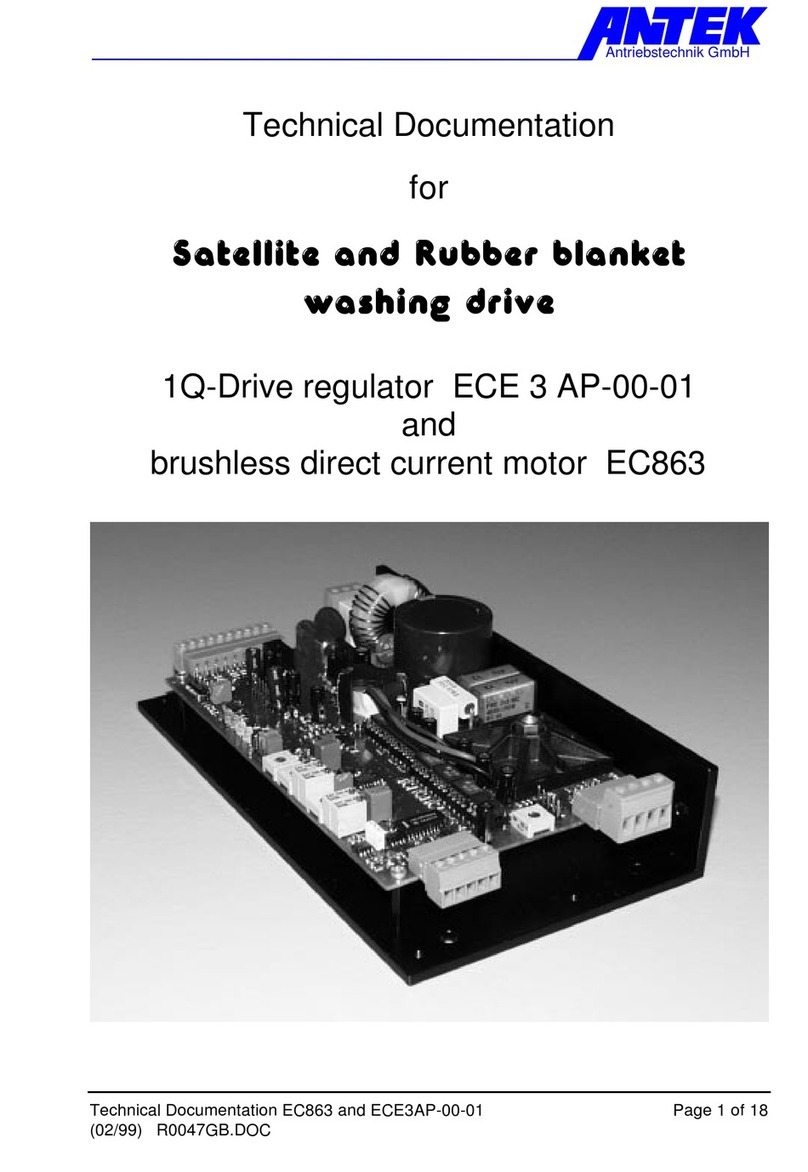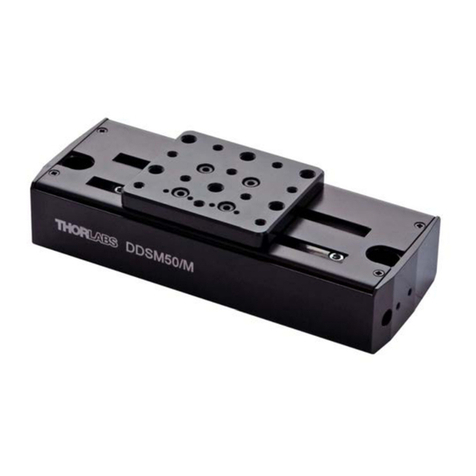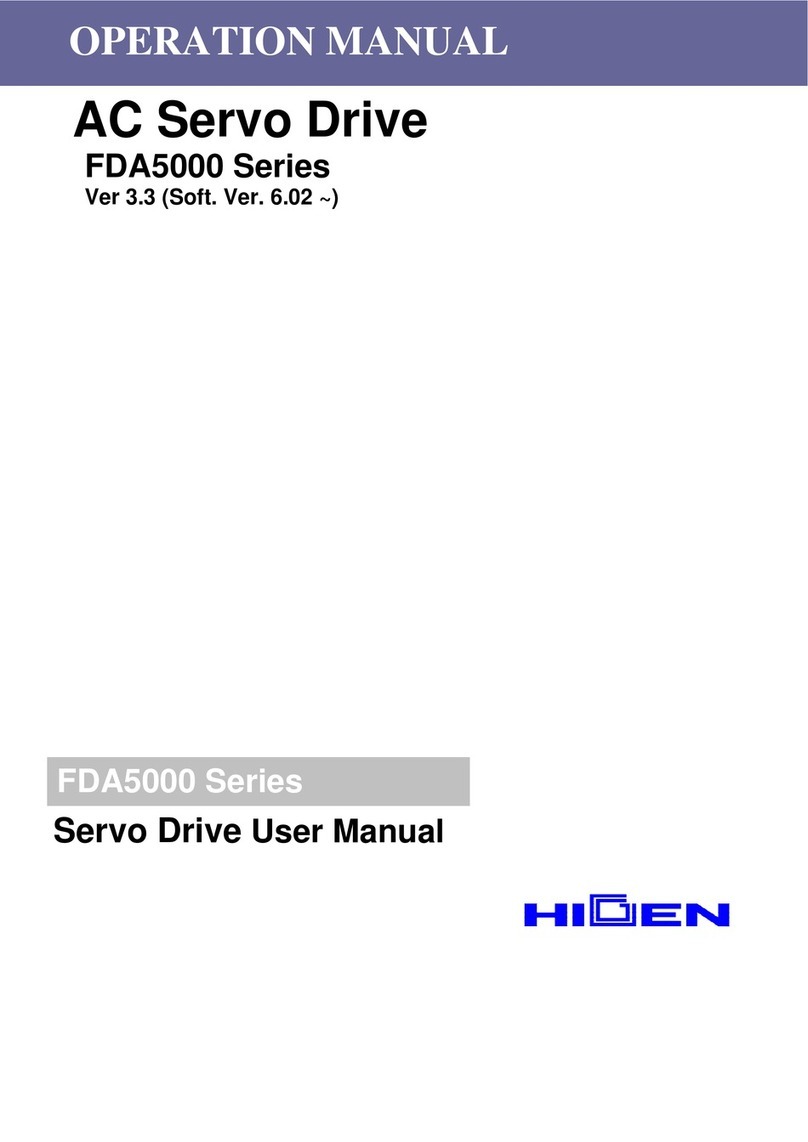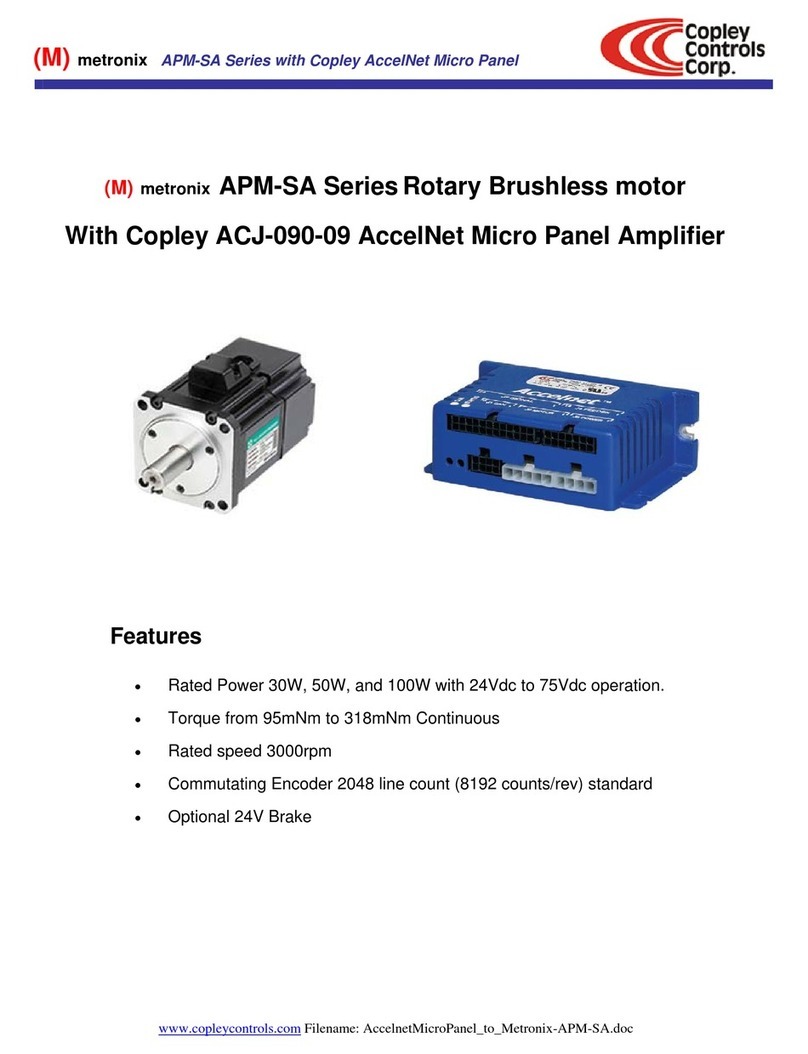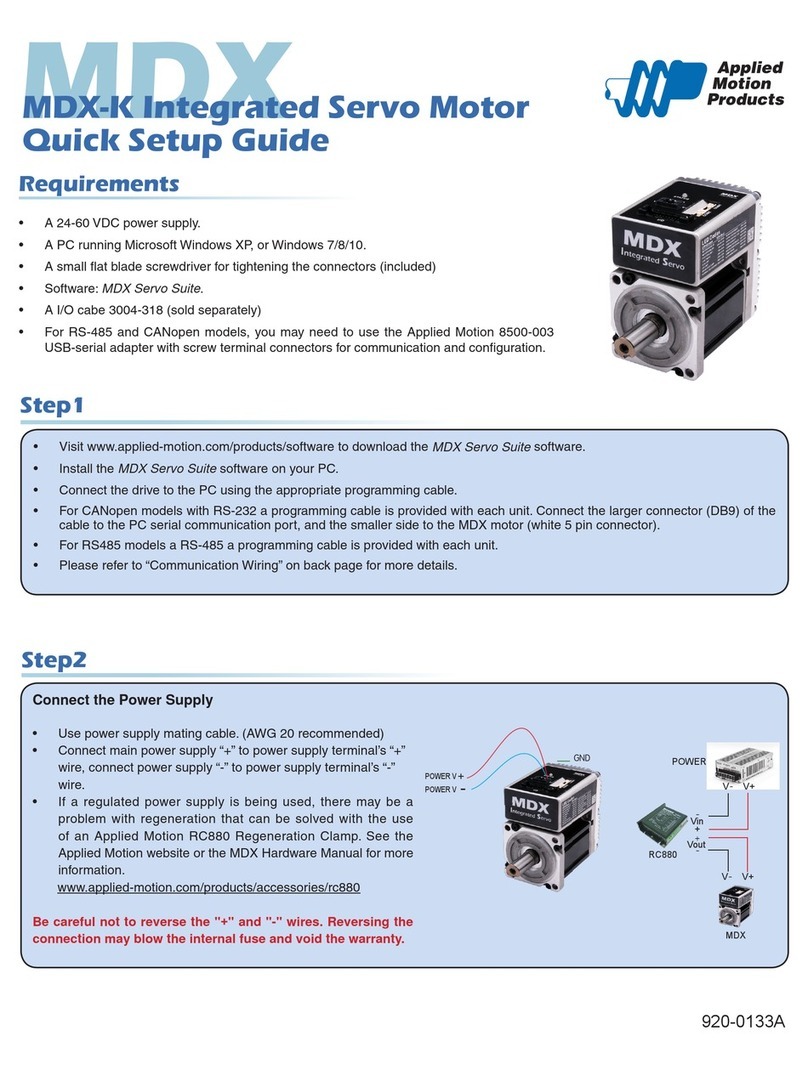Minarik MM23021C User manual

USER’S MANUAL
MM23000 Series
SCR, Dual Voltage,
Adjustable Speed Drives
for DC Brush Motors
Model MM23021C
All manuals and user guides at all-guides.com
all-guides.com

Copyright © 2005 by
Minarik Corporation
All rights reserved. No part of this manual may be reproduced or transmitted in any
form without written permission from Minarik Corporation. The information and
technical data in this manual are subject to change without notice. Minarik
Corporation and its Divisions make no warranty of any kind with respect to this
material, including, but not limited to, the implied warranties of its merchantability
and fitness for a given purpose. Minarik Corporation and its Divisions assume no
responsibility for any errors that may appear in this manual and make no
commitment to update or to keep current the information in this manual.
Printed in the United States of America.
All manuals and user guides at all-guides.com

i
Safety Warnings
•This symbol denotes an important safety tip or warning.
Please read these sections carefully prior to performing any of
the instructions contained in that section.
• Have a qualified electrical maintenance technician install,
adjust, and service this equipment. Follow the National
Electrical Code and all other applicable electrical and safety
codes, including the provisions of the Occupational Safety and
Health Act (OSHA) when installing equipment.
• Reduce the chance of an electrical fire, shock, or explosion by
proper grounding, over current protection, thermal protection,
and enclosure. Follow sound maintenance procedures.
It is possible for a drive to run at full speed as a result of a
component failure. Minarik strongly recommends the
installation of a master switch in the main power input to stop
the drive in an emergency.
This drive is isolated from earth ground. Circuit potentials
are at 115 VAC or 230 VAC above earth ground. Avoid direct
contact with the printed circuit board or with circuit elements
to prevent the risk of serious injury or fatality. Use a non-
metallic screwdriver for adjusting the calibration trimpots.
Use approved personal protective equipment and insulated
tools if working on this drive with power applied.
All manuals and user guides at all-guides.com

ii
Contents
Safety Warnings i
Specifications 1
Dimensions 2
Installation 3
Mounting . . . . . . . . . . . . . . . . . . . . . . . . . . . . . . . . . . . . . . . . . . . . . . . . . . . . .3
Heat sinking . . . . . . . . . . . . . . . . . . . . . . . . . . . . . . . . . . . . . . . . . . . . . . . . . .3
Field output . . . . . . . . . . . . . . . . . . . . . . . . . . . . . . . . . . . . . . . . . . . . . . . . . .4
Connections . . . . . . . . . . . . . . . . . . . . . . . . . . . . . . . . . . . . . . . . . . . . . . . . . .5
Speed adjust potentiometer installation . . . . . . . . . . . . . . . . . . . . . . . . . . . . .6
Shielding guidelines . . . . . . . . . . . . . . . . . . . . . . . . . . . . . . . . . . . . . . . . . . . .7
Voltage follower . . . . . . . . . . . . . . . . . . . . . . . . . . . . . . . . . . . . . . . . . . . . . . .8
Operation 9
Before applying power . . . . . . . . . . . . . . . . . . . . . . . . . . . . . . . . . . . . . . . . . .9
Startup . . . . . . . . . . . . . . . . . . . . . . . . . . . . . . . . . . . . . . . . . . . . . . . . . . . . .10
Line starting and line stopping . . . . . . . . . . . . . . . . . . . . . . . . . . . . . . . . . . .10
Inhibit terminals . . . . . . . . . . . . . . . . . . . . . . . . . . . . . . . . . . . . . . . . . . . . . .11
Decelerating to minimum speed . . . . . . . . . . . . . . . . . . . . . . . . . . . . . . . . .12
Dynamic braking . . . . . . . . . . . . . . . . . . . . . . . . . . . . . . . . . . . . . . . . . . . . . .13
Calibration 15
MINIMUM SPEED (MIN SPD) . . . . . . . . . . . . . . . . . . . . . . . . . . . . . . . . . . .17
MAXIMUM SPEED (MAX SPD) . . . . . . . . . . . . . . . . . . . . . . . . . . . . . . . . . .17
TORQUE . . . . . . . . . . . . . . . . . . . . . . . . . . . . . . . . . . . . . . . . . . . . . . . . . . . .18
IR COMPENSATION (IR COMP) . . . . . . . . . . . . . . . . . . . . . . . . . . . . . . . . .19
ACCELERATION (ACCEL) . . . . . . . . . . . . . . . . . . . . . . . . . . . . . . . . . . . . .20
DECELERATION (DECEL) . . . . . . . . . . . . . . . . . . . . . . . . . . . . . . . . . . . . .21
All manuals and user guides at all-guides.com

iii
Tables
Table 1. Field Output Connections . . . . . . . . . . . . . . . . . . . . . . . . . . . . . . . . . . . . .4
Table 2. Corcom® Filters . . . . . . . . . . . . . . . . . . . . . . . . . . . . . . . . . . . . . . . . . . .37
Table 3. Minarik Filters . . . . . . . . . . . . . . . . . . . . . . . . . . . . . . . . . . . . . . . . . . . . .38
Application Notes 23
Multiple fixed speeds . . . . . . . . . . . . . . . . . . . . . . . . . . . . . . . . . . . . . . . . . .23
Adjustable speeds using potentiometers in series . . . . . . . . . . . . . . . . . . . .24
Independent adjustable speeds . . . . . . . . . . . . . . . . . . . . . . . . . . . . . . . . . .25
RUN/JOG switch . . . . . . . . . . . . . . . . . . . . . . . . . . . . . . . . . . . . . . . . . . . . .26
Leader-follower application . . . . . . . . . . . . . . . . . . . . . . . . . . . . . . . . . . . . .28
Single speed potentiometer control of multiple drives . . . . . . . . . . . . . . . . .29
Reversing . . . . . . . . . . . . . . . . . . . . . . . . . . . . . . . . . . . . . . . . . . . . . . . . . . .30
Reversing with a DIGI-LOK® controller, model DLC600 . . . . . . . . . . . . . . .31
Troubleshooting . . . . . . . . . . . . . . . . . . . . . . . . . . . . . . . . . . . . . . . . . . . . . . .32
Before troubleshooting . . . . . . . . . . . . . . . . . . . . . . . . . . . . . . . . . . . . . . . . .32
CE Compliance 36
Line filters . . . . . . . . . . . . . . . . . . . . . . . . . . . . . . . . . . . . . . . . . . . . . . . . . . .37
Armature filters . . . . . . . . . . . . . . . . . . . . . . . . . . . . . . . . . . . . . . . . . . . . . . .38
Functional Diagrams 40
Replacement Parts 41
Limited Warranty inside back cover
All manuals and user guides at all-guides.com

Figure 1. MM23021C Dimensions . . . . . . . . . . . . . . . . . . . . . . . . . . . . . . . . . . . . .2
Figure 2. Chassis Drive Connections to Heat Sink Terminal Boards . . . . . . . . . . .5
Figure 3. Speed Adjust Potentiometer . . . . . . . . . . . . . . . . . . . . . . . . . . . . . . . . . . .6
Figure 4. Voltage Follower Connections . . . . . . . . . . . . . . . . . . . . . . . . . . . . . . . . .8
Figure 5. Voltage Follower Connections With Signal Greater than 3.5VDC . . . . . .8
Figure 6. Voltage Switches . . . . . . . . . . . . . . . . . . . . . . . . . . . . . . . . . . . . . . . . . . .9
Figure 7. INHIBIT Terminals . . . . . . . . . . . . . . . . . . . . . . . . . . . . . . . . . . . . . . . . .11
Figure 8. Run/Decelerate to Minimum Speed Switch . . . . . . . . . . . . . . . . . . . . . .12
Figure 9. Dynamic Brake Connections . . . . . . . . . . . . . . . . . . . . . . . . . . . . . . . . .14
Figure 10. Calibration Trimpot Layout . . . . . . . . . . . . . . . . . . . . . . . . . . . . . . . . . .16
Figure 11. Typical TORQUE and IR COMP Settings . . . . . . . . . . . . . . . . . . . . . .22
Figure 12. Multiple Fixed Speeds . . . . . . . . . . . . . . . . . . . . . . . . . . . . . . . . . . . . .23
Figure 13. Adjustable Fixed Speeds Using Potentiometers in Series . . . . . . . . . .24
Figure 14. Independent Adjustable Speeds . . . . . . . . . . . . . . . . . . . . . . . . . . . . .25
Figure 15. RUN/JOG Switch Connection to Inhibit Plug . . . . . . . . . . . . . . . . . . . .27
Figure 16. RUN/JOG Switch Connection to Speed Adjust Potentiometer . . . . . .27
Figure 17. Leader-Follower Application . . . . . . . . . . . . . . . . . . . . . . . . . . . . . . . . .28
Figure 18. Single Speed Potentiometer Control of Multiple Drives . . . . . . . . . . . .29
Figure 19. Reversing Circuit Connection . . . . . . . . . . . . . . . . . . . . . . . . . . . . . . .30
Figure 20. Reversing with a DLC600 . . . . . . . . . . . . . . . . . . . . . . . . . . . . . . . . . .31
Figure 21. MM23000 Series Block Diagram . . . . . . . . . . . . . . . . . . . . . . . . . . . . .40
iv
Illustrations
All manuals and user guides at all-guides.com
all-guides.com

Max.
Armature Max HP Max HP
Current with 115 VAC with 230 VAC
Model (Amps DC) Applied Applied Style
MM23021C 18 1½ 3 Chassis
AC Line Voltage 115 VAC or 230 VAC ±10%, 50/60 Hz, single phase
Armature Voltage (115 VAC Input) 0–90 VDC
Armature Voltage (230 VAC Input) 0–180 VDC
Form Factor 1.37 at base speed
Analog Input Voltage Range (signal must be isolated) 0 – 3.5 VDC
Field Voltage (115 VAC Input) 50 VDC (F1 to L1); 100 VDC (F1 to F2)
Field Voltage (230 VAC Input) 100 VDC (F1 to L1); 200 VDC (F1 to F2)
Max. Field Current 1 ADC
Input Impedance (S1 to S2) 100K ohms
Load Regulation 1% base speed or better
Vibration 0.5g max (0–50 Hz)
0.1g max (>50 Hz)
Safety Certification UL Recognized Component, file # E132235
CSA Certified Component, file # LR41380
CE Certificate of Compliance
Ambient Temp. Range (chassis drive) 10°C–55°C
Weight 1.5 lb.
1
Specifications
All manuals and user guides at all-guides.com

2
Dimensions
Figure 1. MM23021C Dimensions
ALL DIMENSIONS IN INCHES [MILLIMETERS]
1
DECELACCEL
S3
S2
INH IB IT
P501 P502
SO501
C504
MIN SPDMAX SPD TORQUE
P503
180
90
SW502 IL50 1
P504 P505
CL
MOV501
L1
L2
F1
T501
MOV503
115 230
SW501
F2
SCR501 D501
R502
SO502
+
METER
-
D502
A2
MOV502
D503
A1
IR COMP
P506
IC501
C502
S1
C503
IC502
C501
R501
SCR502
110V
230V
A1 A2
12345
1.375
7.000" 9.800"
6.900"
6.300"
0.125"
2.455"
7.00”
[178]
9.80
[249]
1.375
[35]
6.30 [160]
2.455 [62]
0.125 [3]
6.90 [175]
All manuals and user guides at all-guides.com

3
Mounting
• Drive components are sensitive to electrostatic fields. Avoid
direct contact with the circuit board. Hold drive by the chassis
only.
• Protect the drive from dirt, moisture, and accidental contact.
Provide sufficient room for access to the terminal block and
calibration trimpots.
• Mount the drive away from heat sources. Operate the drive
within the specified ambient operating temperature range.
• Prevent loose connections by avoiding excessive vibration of
the drive.
• Mount drive with its board in either a horizontal or vertical
plane. Four 0.19 inch (5 mm) wide slots in the chassis accept
#8 pan head screws. Fasten either the large base or the narrow
flange of the chassis to the subplate.
• The chassis must be earth grounded. To ground the chassis, use
a star washer beneath the head of at least one of the mounting
screws to penetrate the anodized chassis surface and to reach
bare metal.
Heat sinking
The MM23021 has sufficient heat sinking in its basic
configuration. No additional heat sinking is necessary.
Installation
All manuals and user guides at all-guides.com

Installation
4
Field output
The field output is for shunt wound motors only. Do not make
any connections to F1 and F2 when using a permanent
magnet motor. See Table 1 for field output connections.
Table 1. Field Output Connections
Line Voltage Approximate Connect Motor
(VAC) Field Voltage (VDC) Field To
115 50 F1 and L1
115 100 F1 and F2
230 100 F1 and L1
230 200 F1 and F2
Use 18 AWG wire to connect the field output to a shunt wound
motor.
All manuals and user guides at all-guides.com

DECELACCEL MIN SPDMAX SPD TORQUE IR COMP
A1 A2
12345
230 VAC INPUT
115 VAC I NPUT
EMERGENCY
STOP SWITCHES
MOTOR
+
CW
SPEED
ADJUST
POT
10KΩ
+
FIELD
COI LS
Figure 2. Chassis Drive Connections to Heat Sink Terminal Boards
Connections
5
Installation
NOTE:
Do not connect
field coils if using a
permanent-magnet
motor.
SPEED
ADJUST
POT
10K OHM
FIELD
COILS
115 VAC INPUT
EMERGENCY
STOP SWITCHES
230 VAC INPUT
+
+
CW
MOTOR
All manuals and user guides at all-guides.com
all-guides.com

6
Warning
Be sure that the potentiometer tabs do not make contact with
the potentiometer enclosure. Grounding the input will cause
damage to the drive.
Install the circular insulating disk between the panel and the 10K
ohm speed adjust potentiometer. Mount the speed adjust
potentiometer through a 0.38 inch (10 mm) hole with the
hardware provided (Figure 3). Twist the speed adjust
potentiometer wire to avoid picking up unwanted electrical noise.
If potentiometer leads are longer than 18 inch (457 mm), use
shielded cable.
POT TAB ASSIGNMENTS
WIPER
CW
CCW
SPEED ADJUST
POTENTIOMETER
INSULATING DISK
PANEL
STAR
WASHER
NUT
MOUNT THROUGH A 0.38 IN. (10 MM) HOLE
Figure 3. Speed Adjust Potentiometer
Speed adjust potentiometer installation
Installation
NUT
STAR
WASHER
PANEL
CW
CCW
WIPER
SPEED ADJUST
POTENTIOMETER
INSULATING DISK POT TAB ASSIGNMENTS
MOUNT THROUGH A 0.38 IN. (10 MM) HOLE
All manuals and user guides at all-guides.com

7
As a general rule, Minarik recommends shielding of all
conductors.
If it is not practical to shield power conductors, Minarik
recommends shielding all logic-level leads. If shielding logic
level leads is not practical, the user should twist all logic leads
with themselves to minimize induced noise.
It may be necessary to earth ground the shielded cable. If noise is
produced by devices other than the drive, ground the shield at the
drive end. If noise is generated by a device on the drive, ground
the shield at the end away from the drive. Do not ground both
ends of the shield.
If the drive continues to pick up noise after grounding the shield,
it may be necessary to add AC line filtering devices, or to mount
the drive in a less noisy environment.
Logic wires from other input devices, such as motion controllers
and PLL velocity controllers, must be separated from power lines
in the same manner as the logic I/O on this drive.
Warning
Under no circumstances should power and logic leads be
bundled together. Induced voltage can cause unpredictable
behavior any electronic device, including motor controls.
Shielding guidelines
Installation
All manuals and user guides at all-guides.com

8
Figure 5. Voltage Follower
Connections With Signal
Greater than 3.5VDC
3
5
4+(POS)
-(NEG)
1
2
3
4
5
TERMINAL
BOARD
NEG
(-)
POS
(+)
SIGNAL INPUT
SPEED
ADJUST
POT
10KΩ
Voltage follower
Instead of using a speed adjust potentiometer, the drive may be
wired to follow an analog input voltage signal (0 – 3.5 VDC) that
is isolated from earth ground (Figure 4). Connect the signal input
(+) to terminal 4. Connect the signal common (–) to terminal 3.
Make no connection to 5.
If the maximum signal is greater than 3.5V, use the speed adjust
pot as a trimmer. See Figure 5 for connections. With the signal at
maximum, use the speed adjust pot to set the motor to the desired
maximum speed. It is advised that the speed adjust pot be
secured to preclude inadvertent tampering with this important
setting.
Installation
Figure 4. Voltage Follower
Connections
SIGNAL INPUT
POS ( + )
NEG ( - )
TERMINAL
BOARD
SPEED
ADJUST
POT
10 K OHM
NEG
( - )
1
2
3
4
5
3
4
5
POS
( + )
All manuals and user guides at all-guides.com

9
Before applying power
•Set voltage switch SW501 to either 115V or 230V to match the
AC line voltage. Set voltage switch SW502 to either 90V or
180V to match the maximum armature voltage (see Figure 6).
Operation
Figure 6. Voltage Switches
DECELACCEL
S3
S2
INHIBIT
P501 P502
SO501
C504
MIN SMAX SPD
P503
180
90
SW502
P504
L2
115 230
SW501
INPUT VOLTAGE
SELECT SWITCH
(SW501)
ARMATURE VOLTAGE
SELECT SWITCH
(SW502)
Warning
Change voltage switch settings only when the drive is
disconnected from AC line voltage. Make sure both
switches are set to their correct position. If the switches are
improperly set to a lower voltage position, the motor will
not run at full voltage and may cause damage to the
transformer. If the switches are improperly set to a higher
voltage position, the motor will overspeed, which may cause
motor damage.
All manuals and user guides at all-guides.com

10 Operation
Startup
1. Turn the speed adjust potentiometer full counterclockwise
(CCW).
2. Apply AC line voltage.
3. Slowly advance the speed adjust potentiometer clockwise
(CW). The motor slowly accelerates as the potentiometer is
turned CW. Continue until the desired speed is reached.
4. Remove AC line voltage from the drive to coast the motor to a
stop.
Line starting and line stopping
Line starting and line stopping (applying and removing AC line
voltage) is recommended for infrequent starting and stopping of a
drive only. When AC line voltage is applied to the drive, the
motor accelerates to the speed set by the speed adjust
potentiometer. When AC line voltage is removed, the motor
coasts to a stop.
All manuals and user guides at all-guides.com
all-guides.com

11
Inhibit terminals
Short the INHIBIT terminals to coast the motor to minimum
speed (see Figure 7 for INHIBIT terminal location). Reopen the
INHIBIT terminals to accelerate the motor to set speed.
Twist inhibit wires and separate them from other power-carrying
wires or sources of electrical noise. Use shielded cable if the
inhibit wires are longer than 18 inches (46 cm). If shielded cable
is used, ground only one end of the shield to earth ground. Do not
ground both ends of the shield.
Minarik Corporation offers two accessory plug harnesses for
connecting to the INHIBIT terminals: part number 201-0024
[inhibit plug with 18 inches (46 cm) leads]; and part number
201-0079 [inhibit plug with 36 inches (91 cm) leads].
Figure 7. INHIBIT Terminals
Operation
DECELACCEL
S3
S2
INHIB IT
P501 P502
SO501
C504
MIN SPDMAX SPD TORQUE
P503
180
90
SW502 IL501
P504 P505
CL
L2
115 230
SW501 SO502
+
METER
-
IR COMP
P506
IC50
C502
INHIBIT
Terminals
All manuals and user guides at all-guides.com

12 Operation
Decelerating to minimum speed
The switch shown in Figure 8 may be used to decelerate a
motor to a minimum speed. Closing the switch between S1 and
S2 decelerates the motor from set speed to a minimum speed
determined by the MIN SPD trimpot setting. If the MIN SPD
trimpot is set full CCW, the motor decelerates to zero speed when
the switch between S1 and S2 is closed. The DECEL trimpot
setting determines the rate at which the drive decelerates. By
opening the switch, the motor accelerates to set speed at a rate
determined by the ACCEL trimpot setting.
Figure 8. Run/Decelerate to Minimum Speed Switch
SPEED ADJUST
POT
10K OHM
CCW
DECEL TO MIN SPEED
RUN
3
4
5
All manuals and user guides at all-guides.com

13
Dynamic braking
Operation
Warning
For frequent starts and stops, short the inhibit terminals,
decelerate to a minimum speed, or apply a dynamic brake to
the motor. Do not use any of these methods for emergency
stopping. They may not stop a drive that is malfunctioning.
Removing AC line power (both L1 and L2) is the only
acceptable method for emergency stopping.
Frequent starting and stopping can produce high torque. This
may cause damage to motors, especially gearmotors that are
not properly sized for the application.
Dynamic braking may be used to rapidly stop a motor (Figure 9).
For the RUN/BRAKE switch, use a two pole, two position switch
rated for at least 15 amps at 180 VDC. For the dynamic brake
resistor, use a 40 watt minimum, high-power, wire-wound
resistor.
Sizing the dynamic brake resistor depends on load inertia, motor
voltage, and braking time. Use a lower-value, higher-wattage
dynamic brake resistor to stop a motor more rapidly.
All manuals and user guides at all-guides.com

14 Operation
A2
A1 MOTOR
20
Ω
40W
INHIBIT
PINS
RUN
BRAKE
Figure 9. Dynamic Brake Connections
INHIBIT
PINS
A2
A1
40W
20 OHMS
BRAKE
RUN
MOTOR
All manuals and user guides at all-guides.com
This manual suits for next models
1
Table of contents
Popular Servo Drive manuals by other brands

GORBEL
GORBEL G-Force iQ Series Installation & operation manual

Sinee
Sinee EA180 Series manual

Mitsubishi Electric
Mitsubishi Electric Melservo-H Series Specifications and Instruction Guide
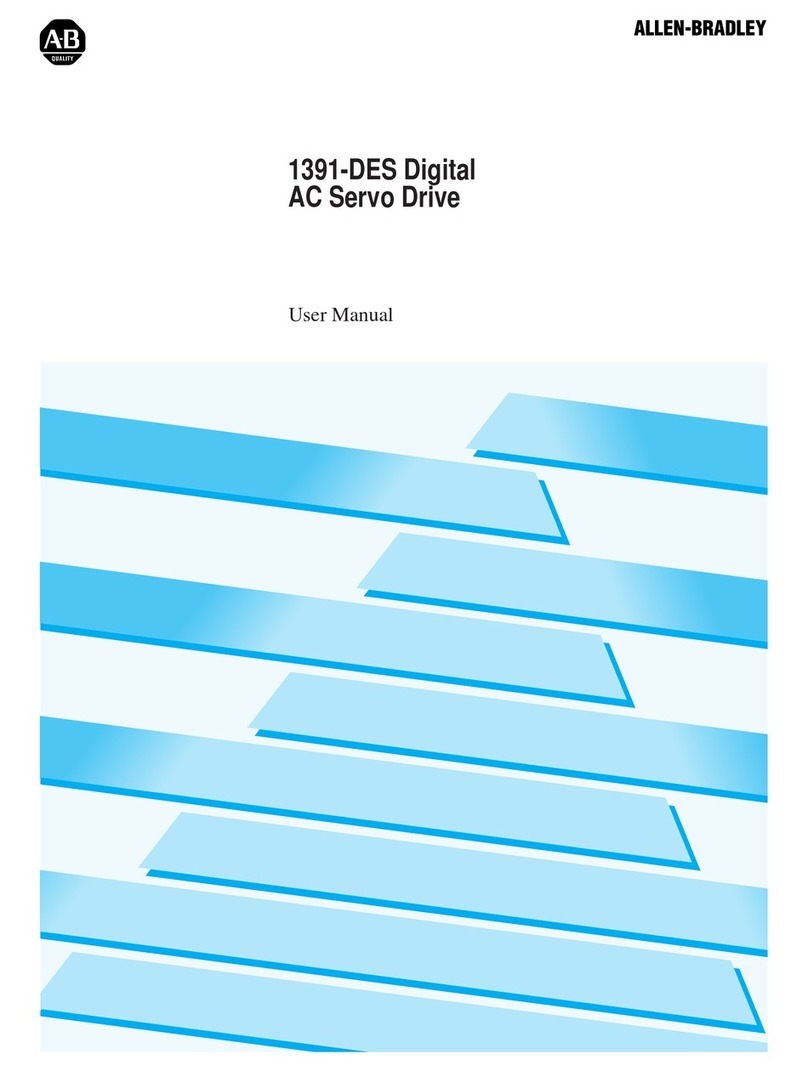
AB Quality
AB Quality ALLEN-BRADLEY 1391-DES user manual
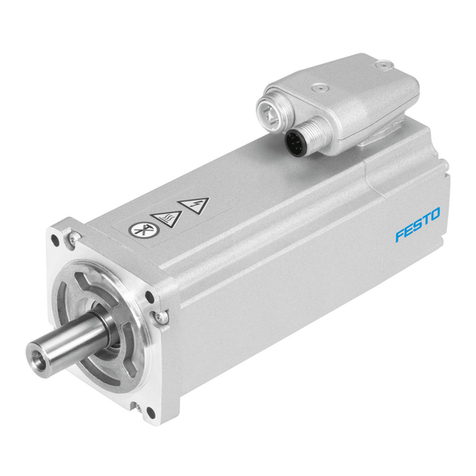
Festo
Festo EMME-AS-100-S Series operating instructions
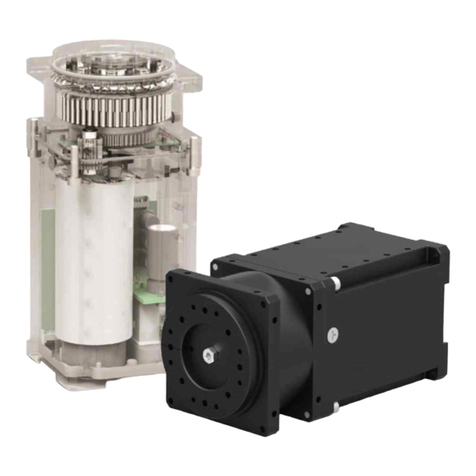
Robotis
Robotis Dynamixel Pro quick start
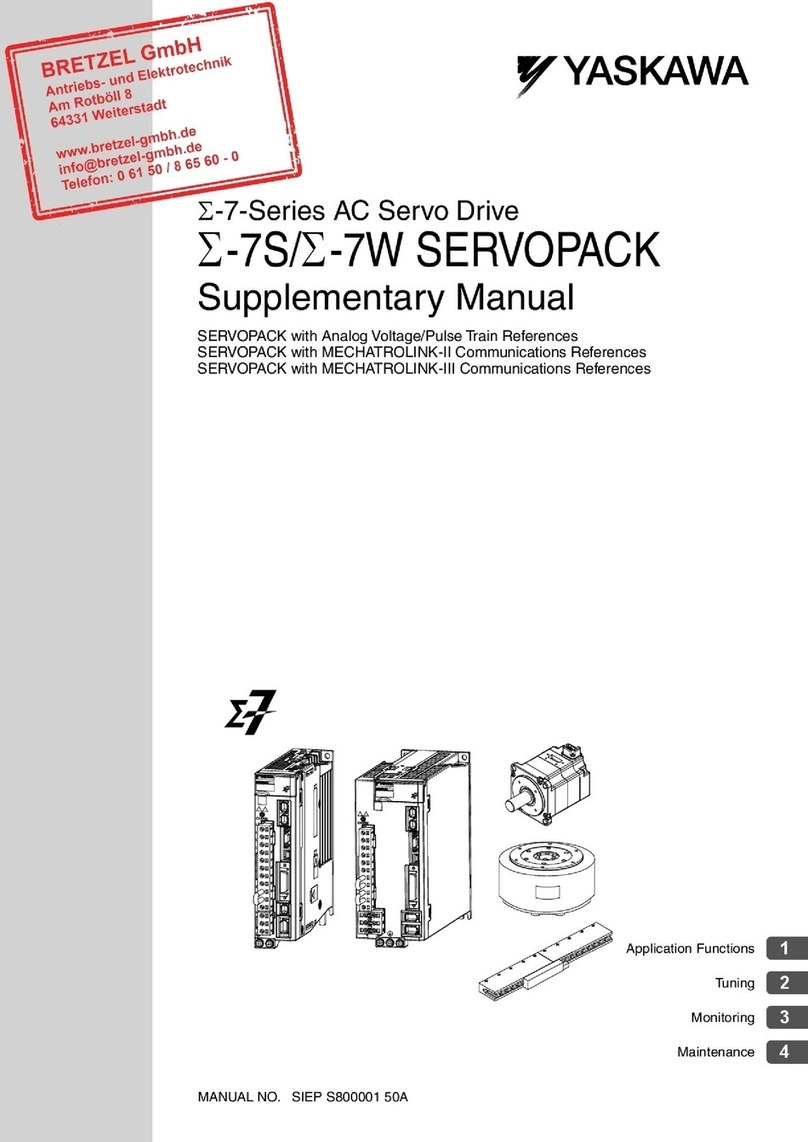
YASKAWA
YASKAWA SERVOPACK Sigma 7S Series Supplementary manual
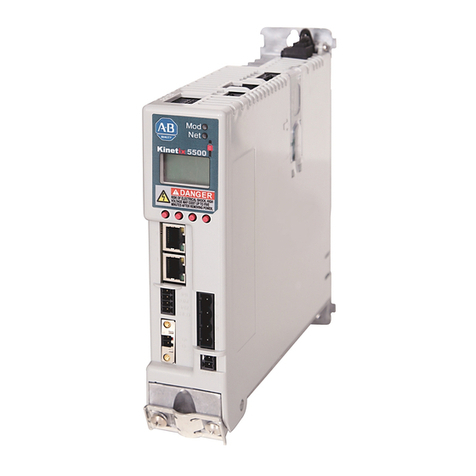
Allen-Bradley
Allen-Bradley Kinetix 5500 series quick start
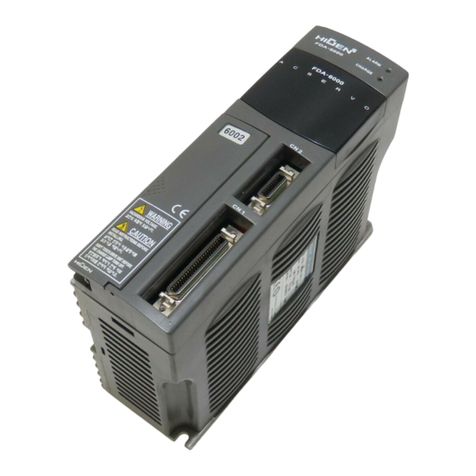
Higen
Higen FDA6000C Series user manual
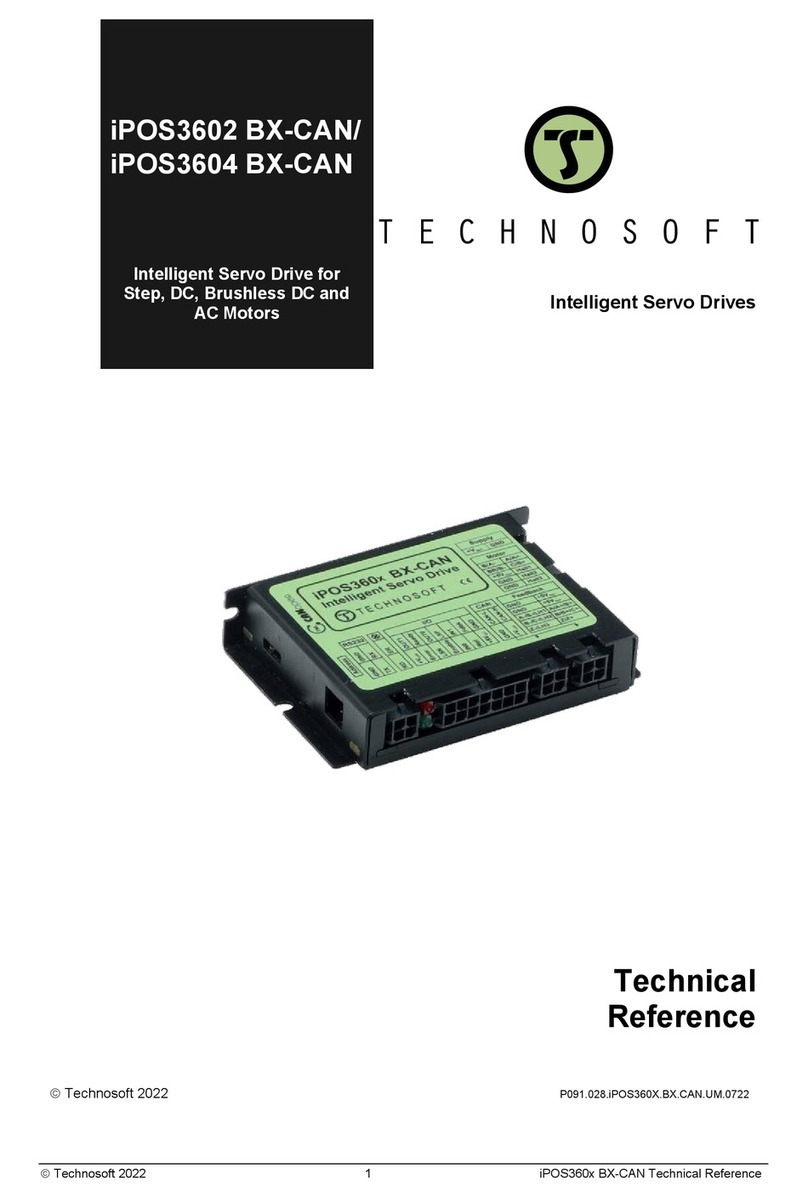
Technosoft
Technosoft iPOS3602 BX-CAN Technical reference
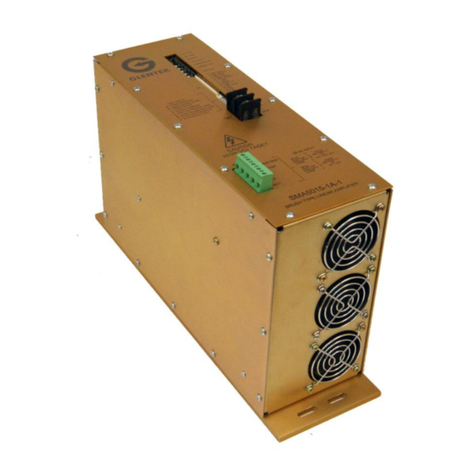
Glentek
Glentek SMA5005 Installation guide, operation & service manual
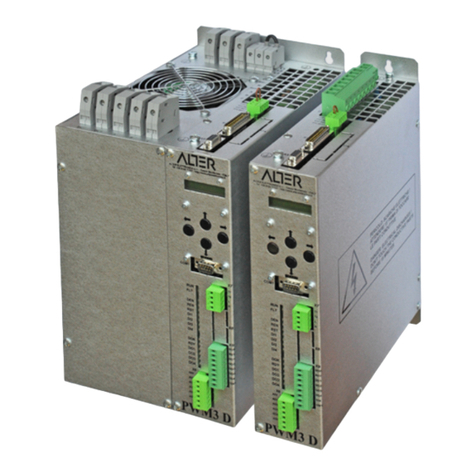
ALTER
ALTER PWM3D-000 manual
